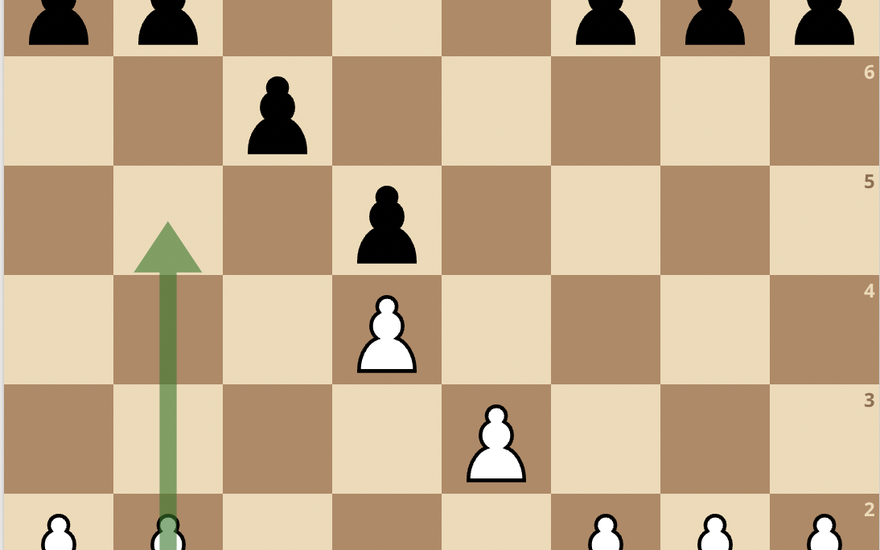
Mastering Mini-games
There's more to the Carlsbad structure than the minority attackIf there’s one plan that seems to get covered in just about every chess strategy book it’s the minority attack. I have to say, I don’t get it. It’s not that the minority attack is a bad strategy or it can’t work, it’s just very specific. If I was writing a strategy book for beginners to intermediate players, I’d start at a much broader level, like, “Where do you put your knights?”
But we’re getting ahead of ourselves. What is the minority attack anyway?
The minority attack is when, in a structure like this, White advances the b-pawn until it comes in contact with Black’s b-pawn. A similar strategy can happen in various pawn structures, but it’s most associated with the one pictured above, the Carlsbad structure. This structure often arises from the Queen’s Gambit. It’s called a minority attack because White is advancing with a pawn minority (the a- and b-pawn vs. Black’s a-, b-, and c-pawns). Then a few things can happen, but all of them end up with Black having a pawn weakness:
- White trades on c6 and Black ends up with a backward pawn on c6.
- Black trades on b5 (we’re assuming White has that pawn defended with a piece) and takes on an isolated d-pawn.
Once you’ve created the pawn weakness, you start piling up pressure by attacking it with more and more pieces. Black’s pieces slip into passive positions trying to defend the pawn. Eventually, you win the pawn anyway, or take advantage of Black’s passivity to break through somewhere else on the board. When it works, it looks like clockwork.
English GM Keith Arkell has made a career out of this plan. Watch as he inexorably grinds down a 2100 opponent. By the way, I’m including all the games in this article as gifs because it would be impractical to go through all of them move-by-move and what I really want is for you to get a sense of how the plan flows throughout the game. But if you’d like to go through the games in more detail, they’re all in this Lichess Study.
So the minority attack can definitely work, but Black has ways to fight against it as well. If you want more detail on those, check out this video by GM Jesse Kraai. In this post I’m going to focus on White’s plans. For me, in the Carlsbad structure, the minority attack is something like Plan C. Let’s look at Plan A and Plan B.
Harry Nelson Pillsbury was a great American player in the late 1800s. He competed on equal footing with world champions Emanuel Lasker and Wilhem Steinitz, but contracted syphilis and experienced a severe decline in health before he got the chance to compete for the title. He played the Queen’s Gambit before it was cool and favored a plan of establishing a knight on e5 supported by a pawn on f4. Using the knight as a beachhead he would then launch an attack on the king. I think of this plan as the “Pillsbury Post-up,” but this is not a well-known name like the minority attack.
If you want to understand more about this strategy, Chess-Network wrote a whole post on this game.
And that’s not all! Another plan was championed by the world champion Mikhail Botvinnik. Trained as an electrical engineer, Botvinnik took a scientific approach to chess, constantly experimenting. Rather than routing the knight to e5 via f3 like Pillsbury, he preferred to develop the king’s knight to e2, leaving f3 open for a pawn, which would support a central advance with e4 to establish a central pawn roller. Here’s a game where he ran over another all-time great, Paul Keres. Curiously, Botvinnik feinted a minority attack with Rab1 before switching to the central plan.
So we’ve seen three different plans in the Carlsbad structure that can all work under the right circumstances. Let’s step back and draw some conclusions.
- GM Max Illingworth wrote a fascinating post on the four levels of opening preparation. His highest level is “implementing full plans that the opponent isn't familiar with.” In each of the three games we looked at, we saw White win fairly easily, even against strong opposition, by executing a plan the opponent didn’t know how to counter.
- Beyond a basic level, much of strategic knowledge is structure-specific. I’ve described chess as being a collection of subgames, each with their own unique strategic rules. Today we looked at the Carlsbad structure, which is especially famous and has relatively well-defined plans for White, but all structures have their own rules. If you watch top-level commentators like Peter Leko or Peter Svidler, you’ll notice that in most positions they already know what they want to do, they’re just trying to figure out how to do it.
The big question then is how to develop this structure-specific knowledge. I’ll offer three suggestions, roughly from best to worst.
- Have a coach or friend explain it to you. If you have access to such a person this is ideal, because they can distill the most important lessons from their experience and present them in a format you can understand, answering questions if necessary.
- Use a book or course. Here the quality of the book/course is extremely important. The best authors include excellent explanations of how to think about the resulting positions, but there are also opening books that are just collections of random moves. One author who really impressed me with his explanations is GM Surya Ganguly.
- Quickly play through a large number of master games. This is one case where I think volume beats depth. What you’re looking for is common patterns that occur in many games. Especially in the decisive games, how did the winning side take control of the game?
- The engine can be helpful if you get a little creative. One way is to play against the engine from the opposite side you’re preparing; i.e., if you’re preparing an opening as White, play against the engine as Black. You’ll see how typical human moves (yours) are crushed by best play. You can also organize an engine tournament from a starting position to generate as many ultra-high-level games as you want, ala Matthew Sadler,but this requires more computer know-how.
If you liked this check out my newsletter where I write weekly posts about chess, learning, and data: https://zwischenzug.substack.com/




